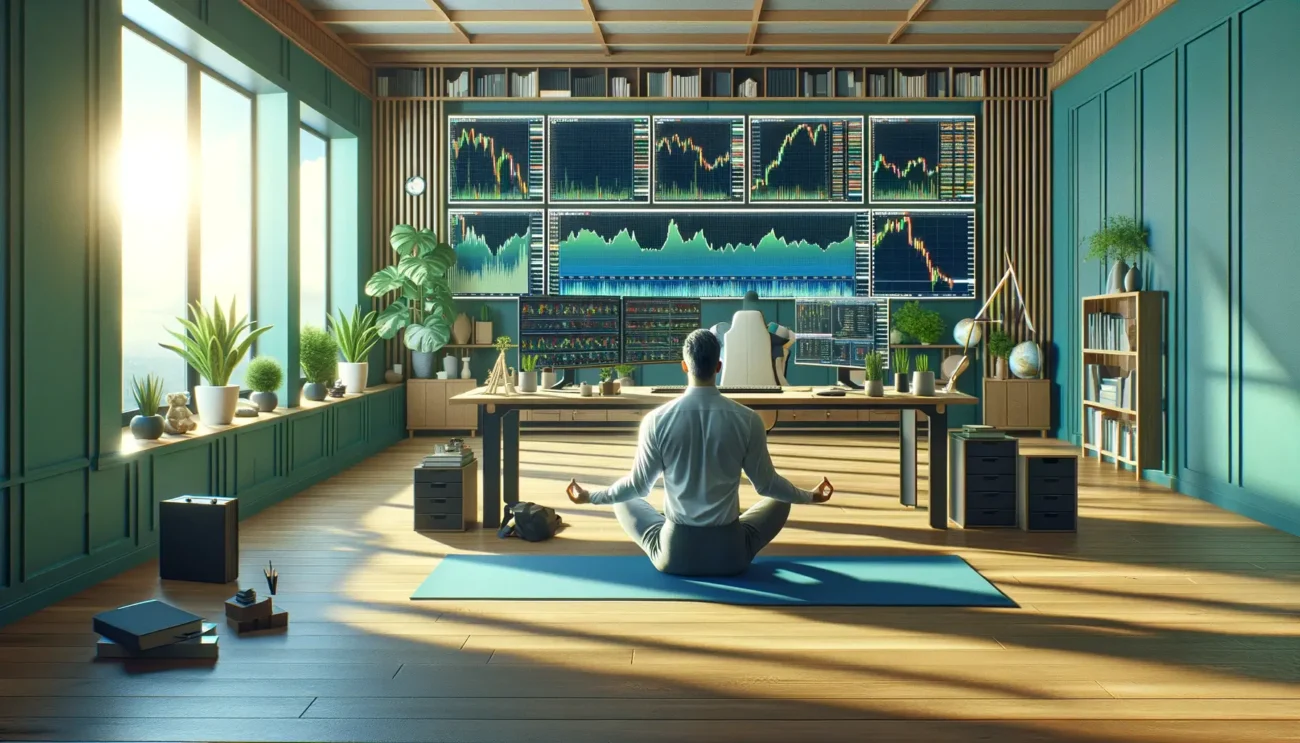The path to success in the financial markets is a journey of constant evolution. For those striving for excellence in trading, embracing Trader Evolution is not just a concept but a vital pursuit. It demands a grasp of trading psychology and a dedication to maintaining mental health in trading, allowing individuals to navigate the market’s ebb and flow with composure and agility. As the markets shift, the trait of market adaptability becomes a beacon, guiding traders through the tumult of economic changes and trend reversals. In this friendly discourse, we unfurl the narrative of becoming an adaptable trader, as one continually hones their craft and mindset to stay competitive and triumphant in the dynamic arena of trading.
Understanding the Dynamics of Modern Markets
The financial markets of today are a fast-paced ecosystem, constantly evolving with the undercurrents of global economies and innovations. Inquisitive traders who desire to master this complex terrain must be well-versed in the currents of market dynamics and the ripples caused by global trading events. Yet at the crux of all this, stands the pioneering spirit of trading technology, shaping the new waves of market trends.
Recognizing Market Trends
Foresight in trading is predicated on recognizing patterns and shifts that delineate market trends. These trends act as compasses, guiding traders toward potential opportunities or away from impending downturns. Charting, historical data analysis, and market sentiment are just the navigation tools for plotting a course through the trends shaping our financial lands.
Impact of Global Events on Trading
Global events, be they economic announcements, geopolitical unrest, or unexpected circumstances like a pandemic, leave indelible imprints on the trading landscape. These events can cause seismic shifts, harnessing the ability to catapult or cripple markets. Understanding their impact and consequent market reactions is paramount for a well-rounded trading strategy that expects the unexpected.
The Role of Technology in Market Evolution
Technological advancement is not just an enhancer of market operations; it is a revolutionary force. Automated trading systems have democratized access, algorithmic strategies have enhanced accuracy and artificial intelligence has introduced a level of predictive analytics once thought fictional. Trading technology is, without a doubt, the architect of modern market evolution, redesigning the parameters of what it means to trade successfully.
Essentials of Trading Psychology
The journey of a trader is as much about mental resilience and emotional discipline as it is about financial acumen. Mastery of trading psychology is critical, involving more than just the knowledge of markets—it’s about fine-tuning the trader’s mindset to navigate through the ebbs and flows of trading life. Let’s delve into why a fortified psychological foundation is not just beneficial but essential for trading success.
Underpinning every successful trade is a series of decisions made amidst uncertainty and risk. Effective mental training trading techniques help traders maintain focus, discipline, and a clear head, especially in the face of volatility. Acknowledging and understanding internal cognitive biases and emotional turbulence can vastly improve decision-making skills. These psychological nuances often separate the proficient traders from the novices.
Developing emotional discipline is an ongoing process, where one learns to detach from wins and losses to maintain a steady trajectory toward their trading goals. This detachment doesn’t imply a lack of passion but rather a controlled engagement, where emotions do not cloud judgment. It’s about striking a fine balance—being driven without being impulsive.
“The market is a device for transferring money from the impatient to the patient.” — Warren Buffett
What does it take to build and nurture the right trader’s mindset? It’s about consistency in Disciplined Trading: 7 Rules for Market Consistencytrading, where habits of the mind are honed with the same rigor as the strategies employed in the markets. Below are key practices for enhancing trading psychology:
- Maintaining a trading journal to reflect on decisions and outcomes.
- Setting realistic goals and sticking to a well-tested trading plan.
- Practicing mindfulness and other stress-reduction techniques.
- Continuous learning to stay nimble and informed.
- Engaging in simulation trading to reinforce good habits without financial risk.
In conclusion, while the markets remain inherently unpredictable, a trader’s response to market events doesn’t have to be. Through diligent mental training and cultivating emotional discipline, traders can forge a mindset capable of withstanding the mental challenges that come with the territory.
The Importance of Mental Training in Trading
Mastering the financial markets requires much more than just analytical skills and a good strategy; it involves strengthening the mind to handle the psychological pressures of trading. Just like athletes who rigorously train to perform under stress, traders benefit from mental preparation to build resilience in trading. This section delves into fundamental emotional regulation strategies and trading stress management tactics that can forge a trader’s psychological armor.
Developing a Resilient Trader’s Mindset
A trader’s mindset is their biggest asset. Cultivating mental toughness allows traders to bounce back from losses and persist in the marathon of market uncertainties. Resilience in trading is built by embracing failures as learning opportunities and viewing challenges as stepping stones to mastery. Mental training strategies like visualization and setting realistic yet challenging goals can also condition the mind for resilience.
Strategies for Emotional Regulation
- Mindfulness Meditation: Engaging in regular mindfulness can help traders remain present and focused, reducing impulsive decisions fueled by emotions.
- Cognitive Restructuring: This involves reframing negative thought patterns into positive ones, aiding in maintaining composure during volatility.
- Journaling: Reflective practice through journaling can offer insights into emotional triggers and help in creating more thoughtful, analytical responses to market events.
Stress Management Techniques for Traders
- Identify Stressors: Recognize what aspects of trading contribute to stress and address them methodically, whether they’re related to risk exposure, overtrading, or lack of preparation.
- Develop Coping Skills: Techniques like deep-breathing exercises, taking breaks, and engaging in physical activity can alleviate stress and renew focus.
- Support Networks: Building a community or seeking mentorship can provide support and reduce isolation, which often exacerbates trading stress.
Having a robust mental framework equips traders not just to survive but to thrive in the markets. By integrating mental training trading routines, traders can fortify their resilience, regulate emotions effectively, and manage stress, paving the way for sustained trading performance and well-being.
Trader Evolution: Embracing Flexibility and Adaptability
The modern trader’s landscape is perpetually shifting, with an array of factors influencing market conditions. It is essential, therefore, for individuals invested in this dynamic environment to harness adaptable trading strategies that can accommodate unpredictability and rapid changes. Embracing a flexible trading approach enables traders to navigate the complexities of the market with agility.
The philosophy of market adaptability isn’t just limited to tactical exchanges but encompasses a comprehensive shift in mindset. To thrive in the financial ecosystem, traders must be willing to pivot strategies in response to new information and evolving trends. This agility, while preserving core investment principles, is vital for the sustained growth and success of a trader’s career.
- Assessing the market for early signals of trend shifts
- Staying informed on geopolitical and economic events that could impact markets
- Utilizing cutting-edge technology for real-time analysis and decision-making
- Adapting position sizing and stop-loss orders to reflect current market volatility
A trader adept in market adaptability not only secures their standing amid volatility but also spots opportunities where others see chaos. Hence, those who evolve with the market, armed with versatile techniques and an adaptive outlook, often find themselves in the vanguard of their field.
Identifying and Overcoming Common Trading Biases
In the journey of financial trading, acknowledging and addressing trading biases is pivotal to maintaining objective decision-making. Traders are often unaware that a cognitive bias in trading can obscure the clarity of their strategies, leading to inconsistent results. Here, we’ll delve into the common biases that distort trading actions and the methodologies you can adopt to overcome biases effectively.
Biases in trading typically originate from psychological tendencies that steer traders away from rational decisions. It is not the market but the mind that often needs the most rigorous discipline. One’s inherent bias can cloud judgment, leading to repetitive patterns of error that can hinder performance and growth.
- Confirmation Bias: The tendency to seek, interpret, and recall information that confirms one’s preconceptions.
- Overconfidence Bias: Exhibiting unwarranted faith in one’s intuitive judgment and abilities.
- Loss Aversion: The propensity to prefer avoiding losses over acquiring equivalent gains.
- Anchoring Bias: Relying too heavily on the first piece of information encountered (the “anchor”) when making decisions.
- Herding Bias: Following the crowd, often disregarding one’s analysis or intuition.
To effectively combat these biases, one must practice a high degree of self-awareness and employ a disciplined trading regime. This involves the relentless scrutiny of one’s thought process and the willingness to challenge and counteract irrational biases.
“Trading requires a balanced amalgam of analysis and intuition, but when biases overshadow rationality, it’s time to recalibrate the scales of judgment.”
Here are a few actionable steps to overcome trading biases:
- Keep a Trading Journal: Documenting your trades, along with the justifications for each decision, can pinpoint where biases may have played a role.
- Develop a Trading Plan: Having a comprehensive plan with predefined rules helps you stick to a strategy rather than emotions or impulses.
- Engage in Continuous Learning: Expand your knowledge to understand the psychological components of trading better.
- Exercise Detachment: Strive to detach from the outcomes of your trades to reduce the impact of emotional responses.
- Seek Diverse Perspectives: Collaboration with a trading community or mentor can provide alternative viewpoints and reduce the vulnerability to personal biases.
Ultimately, overcoming biases in the trading arena is an ongoing effort that requires traders to remain vigilant and open-minded. By embracing self-awareness and implementing strategies to mitigate cognitive biases, traders can aspire to achieve consistency and rationality in their trading activities.
Building a Robust Trading Plan for Volatile Markets
In the realm of finance, the only constant is change. Navigating through volatile markets requires a resilient trading plan that can withstand the whirlwind of global economic shifts. Assembling a dynamic trading strategy is more than a one-time task; it’s an ongoing endeavor that calls for a delicate balance between established principles and adaptive maneuvers.
Key Components of a Dynamic Trading Strategy
A trader’s arsenal should be equipped with a multitude of tools tailored to specific market conditions. The core elements of a dynamic strategy encompass risk management, asset allocation, entry and exit signals, and the flexibility to capitalize on new opportunities as they arise. Understanding these components enables traders to craft strategies that pivot with precision rather than fall prey to market turbulence.
- Risk Management: Tailoring leverage and setting stop-loss thresholds.
- Asset Allocation: Diversifying across various asset classes to mitigate risk.
- Entry and Exit Signals: Identifying clear criteria for market entry and exit points.
- Adaptability Framework: Establishing a system for timely adjustments based on real-time analytics.
Adapting Your Trading Plan to Market Conditions
The sturdiness of a trading plan is tested when market conditions evolve. Trading plan adaptation is not just about making changes; it’s about making the right changes at the right time. A vigilant trader is constantly evaluating, tweaking, and refining their approach based on a keen observation of market trends and economic indicators.
- Regular Review: Continually reassessing the trading plan’s effectiveness in current markets.
- Market Analysis: Integrating comprehensive market studies to inform strategic adaptations.
- Feedback Loops: Implementing mechanisms for learning from trades and integrating insights into future planning.
Importance of Backtesting and Continuous Learning
No strategy can be deemed infallible without the rigorous scrutiny of backtesting. Backtesting evaluates a strategy’s viability by applying it to historical data, providing valuable foresight into potential future outcomes. The cycle of continuous learning and development is what shapes a proficient trader. Through dedication to education and consistent practice, traders can enhance their strategies and refine their execution to thrive within volatile markets.
“The successful warrior is the average man, with laser-like focus.” – Bruce Lee. In trading, this focus translates to a relentless commitment to mastering one’s strategy through perpetual learning and adaptation.
Incorporating Risk Management in Ever-Changing Markets
In the world of trading, risk management is the bedrock upon which sustainable success is built, especially amidst the unpredictable waves of market volatility. Traders who master the art of risk-reward calculation create a buffer against potential losses, allowing them the confidence to make decisions not based on fear, but on informed strategies. It’s through the prudent application of trading discipline that one can navigate the tumultuous waters of financial markets.
Calculating Risk vs. Reward in New Market Environments
Adapting to new market environments requires a recalibration of the traditional risk-reward parameters. Calculating the proper balance involves evaluating potential profit targets against the likelihood of a loss. Traders must carefully weigh their options, considering factors such as:
- Historical volatility patterns
- Current economic indicators
- Geopolitical developments influencing markets
By implementing a dynamic risk-reward calculation process, traders can set realistic expectations for returns and better manage their positions in response to shifting market dynamics.
Maintaining Discipline in the Face of Market Volatility
Trading discipline is the cornerstone of navigating market volatility. A disciplined trader adheres to their trading plan and resist the temptation to make impulsive decisions driven by short-term market movements. Essential to this discipline are:
- Consistent review of trading strategies to align with current market conditions
- Sticking to predefined risk parameters to avoid overexposure
- Utilizing stop-loss orders to manage and minimize potential losses
In the throes of market turbulence, the disciplined trader who prioritizes risk management not only protects their capital but also position themselves to capitalize on opportunities that others may overlook due to panic or indecisiveness.
Leveraging Advanced Technology for Enhanced Trading Performance
The modern financial landscape is ripe with opportunities for traders who can harness advanced trading technology. By integrating algo-trading systems, traders can make more informed decisions powered by trading analytics. The efficient manipulation of big data in trading has become indispensable for gaining insights and developing strategies that can keep up with the pace of today’s markets.
The Role of Algo-Trading in Modern Markets
Algo trading, also known as algorithmic trading, has revolutionized the way traders interact with the market. These sophisticated programs are designed to execute trades at lightning-fast speeds, to capitalize on market efficiencies that would be impossible for manual trading. Algo-trading minimizes human error, streamlines the trading process, and can be tailored to fit a multitude of trading strategies, from arbitrage to trend following.
- Greater accuracy and speed in trade execution
- Reduction of emotional and psychological trading errors
- Ability to backtest strategies using historical data
- Automatic adjustments to trading criteria based on real-time market data
Utilizing Analytics and Big Data for Better Decisions
In a data-driven trading environment, employing comprehensive analytics tools can transform the decision-making process. With the aid of big data, traders can identify patterns, forecast market movements, and gain a competitive advantage. The intersection between trading analytics and big data provides a powerfully predictive approach to trading, empowering traders to make more educated and strategic choices with a higher probability of success.
- Analysis of large and diverse datasets for market insights
- Predictive analytics for potential future market movements
- Customizable indicators and metrics tailored to specific markets or assets
- Real-time data processing for instantaneous feedback on trading strategies
Embracing the digital transformation in trading can lead to increased profitability and performance. The effective use of advanced trading technology, algo-trading, trading analytics, and big data in trading is not just a luxury—it’s become a necessity for the modern trader aiming to stay ahead in the competitive markets of today and tomorrow.
Adapting Your Investment Portfolio for Growth and Sustainability
As the markets continuously shift, adapting your investment portfolio is paramount for achieving portfolio growth while ensuring long-term sustainability. To thrive amidst the ebb and flow of economic changes, we must embrace sustainable trading practices that bolster our financial foundation. Here are strategies refined through years of market experience, ensuring your portfolio stays robust and responsive.
- Embrace Diversification: Cliche as it may sound, “don’t put all your eggs in one basket” remains ever-relevant. By spreading investments across various asset classes, industries, and geographies, you mitigate risk and position your portfolio for a smoother growth trajectory.
- Periodic Assessment and Rebalancing: It’s not just about creating a diversified portfolio; it’s about maintaining one. Regular reviews allow for investment portfolio adaptation, ensuring alignment with your financial goals and risk appetite, especially in dynamically changing markets.
- Strategic Shifts for Market Fluctuations: Adaptive strategies are not set-and-forget. They require attentiveness to market signals and the foresight to make strategic shifts without compromising the portfolio’s integrity or its growth potential.
- Invest in Sustainable Ventures: A commitment to sustainability can foster resilience in your portfolio. Investing in companies with ethical practices and robust environmental policies is an investment in the longevity of your assets.
Remember: An adaptable portfolio is one that grows not just with the market but through the market, leveraging fluctuations as opportunities, rather than setbacks.
Integrating these cornerstones into your trading routine could be instrumental in navigating market volatility. Investment portfolio adaptation isn’t merely reactive; it’s a proactive stance towards portfolio growth, balancing the scales between risk and return while fostering sustainable trading practices that ensure prosperity even amidst uncertainty.
Conclusion
The journey through the complex and demanding world of trading has underscored the imperative nature of agility and resilience. With each section, we embarked on an exploration of the facets that foster Trader Evolution – from the psychological rigors to the strategic methodologies that exemplify adaptability in action. As we distilled the essence of these principles, a recurring theme emerged: the critical role of a robust commitment to trading evolution.
Key Takeaways for Continuous Trader Development
Trader development hinges on a multifaceted approach where psychological fortitude and strategic adaptability join forces to propel traders forward. It encompasses the necessity of harnessing emotional discipline, the acumen to discern and navigate market dynamics, and the valor to embrace technological advancements. These components are not just individual skills but are interdependent, converging to shape the comprehensive trader’s mindset.
Staying Ahead in the Trading Game: A Commitment to Evolve
Staying ahead in trading is not achieved by mere participation. It is the fruit of an unyielding commitment to constant learning, reassessment, and the refinement of strategies. It is for those traders who see evolution not as a choice but as an ongoing process – the core ethos that enables them to meet the tides of market change with a poised and prepared approach. Such traders understand that the markets are living entities, forever fluctuating, and that only by evolving within them can they hope to reach the pinnacles of success they aspire to.









Leave a comment